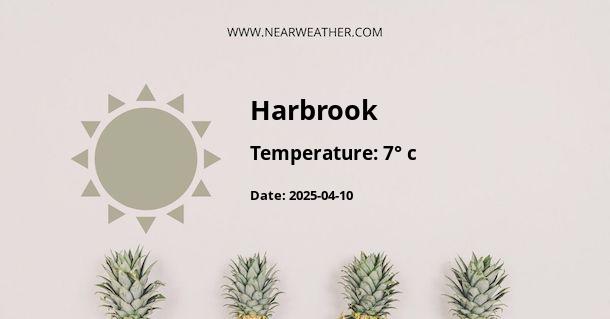Understanding the Climate and Weather Patterns of Harbrook, Delaware
Harbrook, Delaware is a location with distinctive weather and climate characteristics that reflect its position on the Eastern Seaboard of the United States. With the Atlantic Ocean in close proximity, Harbrook's climate can be classified as humid subtropical (Cfa) according to the Köppen climate classification system. This implies that the area experiences hot, humid summers and generally mild to cool winters, with precipitation distributed fairly evenly throughout the year.Seasonal Weather Overview
The climate in Harbrook, Delaware, is influenced by its latitude, coastal location, and, to some extent, by weather patterns that roll in from the interior of the continent.
Winter
- Temperature: Average high temperatures range from 38°F to 47°F, with lows averaging between 24°F and 34°F.
- Precipitation: Snowfall averages around 20 inches per year, with occasional nor'easters bringing heavy snow and blizzard conditions.
- Months: December to February
Spring
- Temperature: Average high temperatures range from 58°F to 76°F, with lows averaging between 37°F and 56°F.
- Precipitation: The region experiences a significant amount of rainfall during spring, contributing to the lush vegetation.
- Months: March to May
Summer
- Temperature: Average high temperatures range from 85°F to 89°F, with lows averaging between 65°F and 69°F.
- Humidity: The proximity to the ocean tends to increase humidity levels, sometimes leading to uncomfortable conditions.
- Months: June to August
Fall
- Temperature: Average high temperatures range from 75°F to 58°F, with lows averaging between 54°F and 39°F.
- Precipitation: Autumn is often the driest season, although tropical systems can occasionally affect the area.
- Months: September to November
Monthly Weather Statistics
To illustrate Harbrook's climatic conditions more precisely, let's delve into the monthly averages table, showcasing temperature and precipitation data:| Month | Average High (°F) | Average Low (°F) | Precipitation (inches) |
|---|---|---|---|
| January | 38 | 24 | 3.0 |
| February | 41 | 26 | 2.7 |
| March | 50 | 34 | 4.1 |
| April | 62 | 42 | 3.9 |
| May | 72 | 52 | 4.1 |
| June | 82 | 62 | 3.0 |
| July | 87 | 68 | 4.5 |
| August | 85 | 66 | 4.0 |
| September | 78 | 59 | 4.0 |
| October | 67 | 47 | 3.4 |
| November | 55 | 37 | 3.1 |
| December | 45 | 29 | 3.3 |
Annual Weather Trends
Annual precipitation in Harbrook averages around 45 inches, with no distinct dry season due to its humid subtropical climate.
| Total Annual Precipitation | Average Annual Temperature | Yearly Snowfall |
|---|---|---|
| 45 inches | ~59.5°F | 20 inches |
Extreme Weather and Climate Events
Harbrook, DE, although not frequently at the epicenter of extreme weather, is still susceptible to the impacts of such events. Hurricanes and tropical storms, while usually of weakened strength by the time they reach this latitude, can still cause significant damage through storm surges, flooding, and high winds. Snowstorms during the colder months can cripple transportation and lead to power outages. Heatwaves in the summer months, particularly exacerbated by the urban heat island effect, pose health risks, especially to vulnerable populations.
Climate Influences
Several factors contribute to the weather and climate patterns observed in Harbrook:
- Coastal Proximity: The Atlantic Ocean, particularly the Gulf Stream, plays a major role in moderating temperatures and providing moisture that affects precipitation patterns.
- Latitude: Harbrook's position on the globe affects the amount of solar radiation it receives, influencing seasonal temperature variations.
- Topography: The region's flat landscape allows for weather patterns to move relatively unhindered across the area, while also being subject to whatever systems develop off the Eastern Seaboard.
- Jetting Weather Fronts: As cold air masses descend from Canada and meet the warm air from the Gulf of Mexico, weather fronts form, leading to diverse and sometimes rapid weather changes.
Future Climate Considerations
Climate change projections suggest several changes may occur in Harbrook's climate. These include an increase in average temperatures, leading to hotter and possibly longer summers, and milder winters, with the possibility of reduced snowfall. Precipitation patterns may shift, with heavier rainfall events becoming more common and potentially leading to an increased risk of flooding. Sea-level rise is also a concern for coastal areas, potentially impacting Harbrook indirectly through changes in weather patterns, or directly through storm surge events.
Preparedness for Weather and Climate Conditions
Residents and visitors in Harbrook are advised to stay informed about current weather forecasts and to understand the climatic trends that may affect them seasonally. Preparation for extreme weather, such as stocking emergency supplies and understanding evacuation routes during hurricanes, is recommended. Awareness of the typical weather patterns allows for better planning for activities such as agriculture, tourism, and infrastructure development, as well as personal safety.
Climate and Weather Insights for Harbrook, Delaware
In summary, Harbrook, Delaware experiences a humid subtropical climate with hot summers and mild winters. The region's weather is influenced by its coastal location, with precipitation relatively evenly spread throughout the year. While extreme weather such as hurricanes and blizzards does occur, they are not the norm. However, due to ongoing climatic changes, the frequency and intensity of such events may change in the future. Understanding these patterns allows residents and stakeholders in Harbrook to adapt and prepare accordingly, ensuring resilience in the face of variable and changing weather conditions.
A - Harbrook's Latitude is 53.700001 & Longitude is 9.833330.
A - Weather in Harbrook is 11° today.
A - Climate Conditions in Harbrook shows broken clouds today.
A - Humidity in Harbrook is 88% today.
A - Wind speed in Harbrook is 20.38 km/h, flowing at 170° wind direction. today.
